
Gothic architecture is an architectural style that was prevalent in Europe from the late 12th to the 16th century, during the High and Late Middle Ages, surviving into the 17th and 18th centuries in some areas. It evolved from Romanesque architecture and was succeeded by Renaissance architecture. It originated in the Île-de-France and Picardy regions of northern France. The style at the time was sometimes known as opus Francigenum ; the term Gothic was first applied contemptuously during the later Renaissance, by those ambitious to revive the architecture of classical antiquity.

Piazza San Marco, often known in English as St Mark's Square, is the principal public square of Venice, Italy, where it is generally known just as la Piazza. Almost all the other urban spaces in the city are called campi ("fields"). The Piazzetta is an extension of the Piazza towards San Marco basin in its southeast corner. The two spaces together form the social, religious and political centre of Venice and are referred to together. This article relates to both of them.

The Doge's Palace is a palace built in Venetian Gothic style, and one of the main landmarks of the city of Venice in northern Italy. The palace was the residence of the Doge of Venice, the supreme authority of the former Republic of Venice. It was built in 1340 and extended and modified in the following centuries. It became a museum in 1923 and is one of the 11 museums run by the Fondazione Musei Civici di Venezia.

San Pietro in Bovara is a Romanesque and Gothic-style, Roman Catholic church and abbey located on Via Don Sturzo #2 in Bovara, a frazione of the town of Trevi, in the province of Perugia, region of Umbria, central Italy.
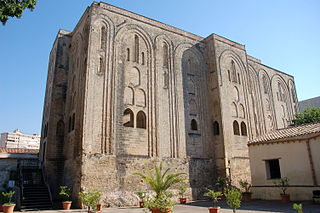
The Cuba is a recreational palace in the Sicilian city of Palermo, originally part of the Sollazzi Regi group of Norman palaces. It was built in 1180 by William II of Sicily in his Royal Park, together with an artificial lake. The name Cuba derives either from its cubical form, or the Arabic Qubba, "dome". It is an imitation of the Zisa palace. In July 2015 it was included in the UNESCO Arab-Norman Palermo and the Cathedral Churches of Cefalù and Monreale World Heritage Site.

Castelbuono is a town and comune in the Metropolitan City of Palermo, Sicily.
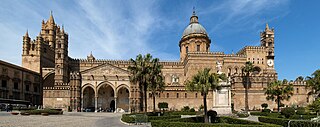
Palermo Cathedral is the cathedral church of the Roman Catholic Archdiocese of Palermo, located in Palermo, Sicily, southern Italy. It is dedicated to the Assumption of the Virgin Mary. As an architectural complex, it is characterized by the presence of different styles, due to a long history of additions, alterations and restorations, the last of which occurred in the 18th century.

San Stae is a church in central Venice, in the sestiere of Santa Croce.

The ruins of the Monastery of Santa Clara-a-Velha are located in the city of Coimbra, in Portugal. The monastery was built in the 14th century on the left bank of the Mondego River, but had to be abandoned in the 17th century due to frequent floods. The well-preserved Gothic ruins of the monastery were excavated in the late 20th century, more than 300 years after being abandoned by the nuns.

Santa Maria del Carmine is a church in Pavia, Lombardy, northern Italy, considered amongst the best examples of Lombard Gothic architecture. It was begun in 1374 by Gian Galeazzo Visconti, Duke of Milan, on a project attributed to Bernardo da Venezia. The construction followed a slow pace, and was restarted in 1432, being finished in 1461.
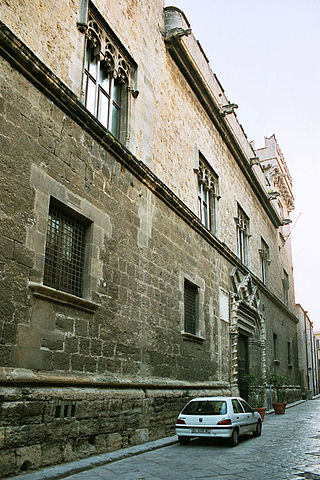
Palazzo Abatellis is a palazzo in Palermo, Sicily, southern Italy, located in the Kalsa quarter. It is home to the Galleria Regionale della Sicilia, the Gallery of Art for the Sicilian region.

Palazzo Chiaramonte-Steri is a Gothic-style palace located on via Piazza Marina, facing the Giardino Garibaldi in the ancient quarter of Kalsa of Palermo, region of Sicily, Italy.

Santa Maria della Pace is a Roman Catholic church attached to a monastery and hospital, located on Via dei Tribunali corner with Via Castel Capuano, just after the piazzetta Sedil Capuano, in Naples, Italy.
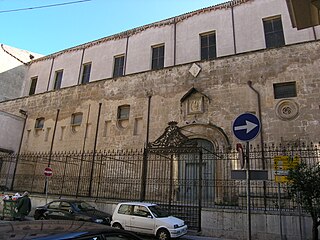
Santa Maria della Gancia, also known as Santa Maria degli Angeli, is a 15th-century Roman Catholic church, adjacent to a convent, located on Via Alloro #27 in central Palermo, region of Sicily, Italy.
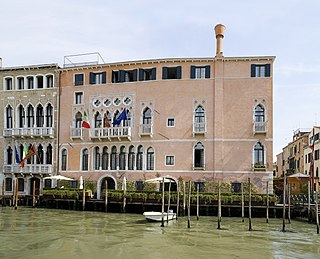
The Ca' Sagredo is a 14th-century Byzantine-Gothic style palace located on the corner of the Strada Nuova and Campo Santa Sofia, in the sestiere of Cannaregio in central Venice, Italy. It now faces the Grand Canal (Venice), and across the campo from the Ca' Foscari. On the left side there is the Palazzo Giustinian Pesaro.

The Praetorian Palace, also known as Palace of the Eagles, is a palace of Palermo. The building has an important role in the political life of the city, since it houses the mayor and the offices of the municipality of Palermo. It is located in the heart of the historic centre, between Via Maqueda, Piazza Pretoria and Piazza Bellini, in the same area of other well-known architectural landmarks like the Fontana Pretoria, the Baroque church of Santa Caterina and the Medieval churches of Martorana and San Cataldo.
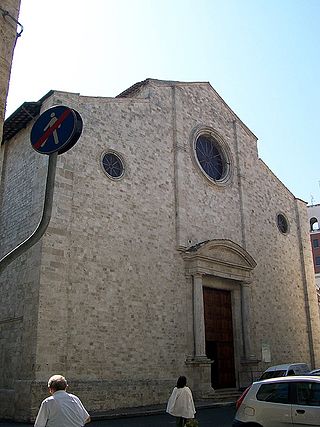
San Pietro Martire is a Gothic-style, Roman Catholic Basilica church located at piazzetta at the intersection of Via delle Torrei, Soderini, and Solestà in the town of Ascoli Piceno in the region of Marche, Italy.

The Palazzo Alliata di Villafranca is former aristocratic mansion, now converted into a museum, located just off Via Vittorio Emanuele facing the Piazza Bologni which opens two blocks west of the Quattro Canti intersection, in the ancient quarter of the Albergaria of the city of Palermo, region of Sicily, Italy.

Palazzo Marchesi is a former aristocratic palace located on Via Santissimi Quaranta Martiri al Casalotto #14, adjacent to the Chiesa del Gesù for which this palace houses a bell-tower, in the ancient quarter of Albergheria, in central Palermo, region of Sicily, Italy. The building presently houses the rare book collection of the Biblioteca Comunale of Palermo.

Madonna dei Rimedi is a Baroque-style, Roman Catholic Sanctuary-church, established and still affiliated with the Discalced Carmelite order, located on Piazza Indipendenza # 9, in Palermo, region of Sicily, Italy.



















